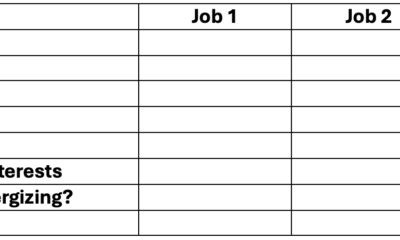Professional Development
Het beheersen van strategische flexibiliteit voor continue bedrijfsevolutie

The Importance of Cultivating Strategic Agility in Today’s Business Landscape
In the current fast-paced and disruptive business landscape, maintaining a balance between stability and flexibility is crucial for long-term success. Organizations need to provide clear direction and adapt quickly to changing circumstances. To achieve this balance, cultivating strategic agility is essential: the ability to recalibrate strategies quickly in response to changes while maintaining a coherent vision.
For business leaders and strategy professionals, fostering strategic agility is essential. This capability enables companies to chart a steady course for the future and effectively maneuver when faced with unexpected challenges. However, achieving true strategic agility requires foresight, meticulous planning, and an agile mindset throughout the organization.
This article explores how organizations can balance stability and flexibility through strategic agility. It will define strategic agility, examine its significance in today’s context, and provide practical recommendations for cultivating it to ensure sustainable business growth.
Understanding Strategic Flexibility
At its core, strategic agility refers to an organization’s ability to adapt its strategies and plans in a timely, coherent manner to changing circumstances while remaining aligned with long-term vision and goals. It encompasses three key pillars:
Perception: The ability to continuously scan the business environment and identify potential threats, opportunities, or weak signals early. This helps organizations remain aware of changing trends and emerging challenges/opportunities.
Response: The agility to seamlessly recalibrate strategies, resource allocation, processes, or structures in response to perceived changes. This enables urgent adjustments to be made when necessary.
Stability: Maintaining the overarching vision, values, culture, and strategic direction despite changes. This anchors the organization and provides consistent guidance in the long term, even during disruptions.
By integrating these three elements, this business strategy helps find a judicious balance between stability and flexibility. It enables organizations to steadily chart their long-term course while maintaining the agility to address challenges and seize opportunities along the way.
The Importance of Strategic Flexibility Today
The contemporary business environment is characterized by unprecedented levels of volatility, uncertainty, complexity, and ambiguity. Disruptive technologies, evolving consumer behavior, geopolitical turbulence, and other macro-forces constantly reshape industries.
Amid these developments, maintaining a single static strategy is unsustainable. Ongoing changes within organizations occur at an accelerated pace, and the half-life of strategies continues to decrease. Those rigidly adhering to predefined plans, without room for recalibration, are at significant risk of falling behind.
Strategic agility has thus become absolutely crucial to remain competitive in today’s time. It offers three key advantages that enable organizations to thrive amidst disruption:
1. Risk Mitigation
By continuously monitoring market and industry trends, strategic flexibility helps companies detect shifts and changes as they occur. This early detection allows them to anticipate potential risks and challenges that these shifts may bring.
They can then develop contingency plans to deal with various scenarios that may arise as a result of these risks. When needed, companies with strategic flexibility can quickly adjust and implement these contingency plans to minimize negative consequences.
For example, by closely monitoring supply chain issues, a manufacturing company can anticipate supply disruptions during a pandemic. It has backup plans in place to prevent production interruptions and mitigate financial risks when disruptions actually occur.
2. Pursuing Opportunities
Agile companies are quick to recognize opportunities amid changes and uncertainties. They respond promptly to capitalize on the benefits of new opportunities as they arise.
For instance, a food delivery startup can leverage its strategic flexibility to take advantage of the boom in its sector during lockdowns. It rapidly scales up operations and expands into new areas, driving high growth and strengthening market position.
3. Future-Proofing
While being responsive, strategically agile companies also have a stable long-term strategic vision. Their strategies are anchored in this vision but allow flexibility in plans and roadmaps.
This balanced approach helps companies future-proof themselves. While they can adapt to changes, they remain focused on their long-term objectives. Even during disruptions like the pandemic, they could adjust their tactics but did not lose sight of their long-term goals.
By evaluating different future scenarios and maintaining decision-making flexibility, agile strategies protect companies from unpredictable future developments. They are prepared to gradually alter course if reality unfolds differently than expected.
With volatility becoming the new normal, strategic flexibility represents a clear competitive advantage. Those who cultivate it are better positioned for both resilience and performance in today’s dynamic market.
Key Steps to Cultivate Strategic Agility
- Encourage an Agile Mindset: Strategic agility starts from within. Leaders must be role models and foster an open, learning-oriented mindset that values change. This forms the basis for an agile culture. Techniques like mentoring, coaching, and growth opportunities can instill such a mindset.
- Encourage Cross-Functional Collaboration: Creating cross-functional, fluid teams brings together different perspectives, enhancing detection capabilities. Their collaboration also speeds up responsive decision-making. Leaders should encourage collaboration across silos.
- Invest in Strategic Scanning: Utilizing tools, AI, and external networks enhances the capabilities for scanning environments. Continuously monitoring weak signals and trends helps in early identification of challenges and opportunities. Budgeting for such scanning is crucial.
- Practice Scenario Planning: Developing thoughtful but flexible scenarios that account for uncertainties, rather than fixed predictions, allows room for maneuvering amid disruptions. Conduct regular scenario planning exercises.
- Institutionalize Reviews: Formal reviews of strategies, plans, and performance checkpoints at regular intervals (quarterly/biannually) and during disruptions help maintain a dynamic approach. Institutionalize such reviews.
- Develop Key Intelligence Metrics: Identifying and tracking key metrics, not only in terms of outcomes but also in scanning, responsiveness, and stability, helps objectively assess flexibility levels and pinpoint areas for improvement.
- Embrace Iterative Development: Instead of the traditional waterfall approach, an iterative, flexible methodology utilizing minimal viable products and constant feedback allows for flexible responsiveness. Allow for experiments.
- Maintain Technology Investments: Strategic agility is technology-dependent today. Continuous investments in digital transformation, business analytics, cloud infrastructure, and collaboration platforms provide the organization with the resources to observe and respond effectively.
- Promote Taking Calculated Risks: Permission to experiment, challenge conventions, and take measured risks in decision-making fosters innovation and promotes a learning attitude that enhances agility. Recognize failures as learning opportunities.
- Build Strategic Partnerships: Collaboration enhances capabilities, reduces uncertainties, and accelerates responses. Partners can be customers, suppliers, governments, universities, or even competitors on non-competitive issues. Build diverse networks.
- Ensure Strong Leadership: Most importantly, agility champions require strong leadership. Leaders must exemplify flexibility through curiosity, adaptability, and empowering autonomy. Their clear vision yet flexibility in implementation inspires the entire organization on its agility journey.
Case studies in organizations like Amazon demonstrate how those excelling in agility relentlessly focused on these aspects to optimize the balance between stability and flexibility. Cultivating a similar ethos requires persistent work but yields immense benefits for organizations in rapidly changing contexts.
Steps to Sustain Agility
While initiating the transformation is a significant milestone, sustaining strategic agility remains an ongoing endeavor. Leaders must integrate agility into the organization’s DNA by:
- Reward and Recognition: Appropriately acknowledging efforts, achievements, and innovation in agility through rewards and recognitions motivates staff to maintain agility as the norm.
- Communication: Consistent communication by leaders emphasizing the principles of agility, progress, and goal-setting fosters awareness and buy-in at all levels, sustaining momentum.
- Training and Development: Continuous learning opportunities help employees stay updated with changing market needs and enhance senses, decision-making, and responsiveness over time.
- Measurement and Feedback: Periodic measurement of agility metrics and qualitative feedback assess performance, strengths, gaps, and lessons. This facilitates improvements.
- Benchmarking: Benchmarking with top organizations stimulates a competitive spirit and drives progress through cross-learning. External perspectives aid in course corrections.
- Crisis Preparedness: Scheduled occasional agility ‘war games’ help in planning crisis-resilient strategies and responsiveness through lessons during disruptive situations that may arise.
- Cultural Assimilation: By instilling agility in strong cultural traits in the long term through rituals, stories, and symbols, it becomes indelibly embedded in the organization’s DNA.
Strategic evaluations during disruptions further illustrate agility and reinforce sustainability. With persistent efforts, organizations can optimize the delicate balance between stability and flexibility to strengthen future-proofing through strategic agility.
Conclusion
In conclusion, the disruptive business environment demands a new strategic capability that can effectively navigate the changing landscape: strategic agility. By developing the ability to continuously perceive shifts, respond effectively, and yet maintain a stable vision, organizations make their strategies future-proof. For business leaders, the emphasis lies in promoting this crucial competency by embedding an agile mindset and enabling mechanisms throughout the organization. This approach harnesses the immense power of strategic flexibility to optimize both current operations and future opportunities.
-

 Professional Development1 month ago
Professional Development1 month agoDrawing up your strategy
-

 Personal Growth2 months ago
Personal Growth2 months agoSucceeding as a ‘parentpreneur’: Top tips
-

 Videos2 months ago
Videos2 months agoGreat Leaders INSPIRE Others To Do Great Things
-

 Productivity1 month ago
Productivity1 month agoHow to Increase Remote Work Productivity
-

 Productivity2 months ago
Productivity2 months agoTips for Boosting Work Productivity
-

 Productivity2 months ago
Productivity2 months ago5 Ways to Increase Your Personal Assistant’s Productivity
-

 Leadership1 month ago
Leadership1 month agoHow to Tackle Big Challenges
-
Leadership1 month ago
Cutting Through the Clutter of Internal Communications























